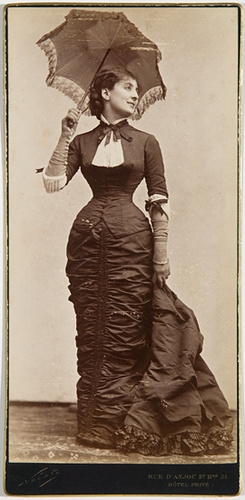
It’s true when you look at photographs from the 1800s or observe antique dresses on custom-made mannequins it’s not hard to envy those petite waistlines. Do you do this?
This perception usually leads to the generic thought: “Teeny, tiny waists are what women strived for back then. Everyone wanted an 18″ waist!”
But did they?…
I love Gone With The Wind. I do.
But I also don’t, because it’s put this *thing* in our modern heads that every girl wanted the smallest waist possible. That women back then cinched their corsets so tightly that they fainted.
Well I think this is a bunch of crap!
Honestly, it’s simply what people wore as clothing. And when we look at it through 21st Century eyes we see it as very, very restrictive. They can’t eat. They can’t breathe. They faint a lot. All for a little, itty-bitty waist. But that’s a 21st Century perspective. It’s a bunch of crap that they couldn’t live life normally.
We *think* they laced so tightly that they couldn’t breathe or eat. I personally don’t believe that.

And the 18 inches thing – no. Forget it. ‘Cause when you look at original corsets and you measure them, the smallest ones usually measure between 20″ and 22.”
Then you start comparing numerous measurements and discover many of them fall into the 20″ to 26″ category. That’s the measurement of the corset. When wearing corsets you always allow about a 2″ gap and that’s on the small size. Many women wore them with 4″ gaps.
So say you add 2″ to a corset measurement. You then learn women’s natural waists were between 22″ to 28″. That’s not unheard of today! It’s merely on the small side.
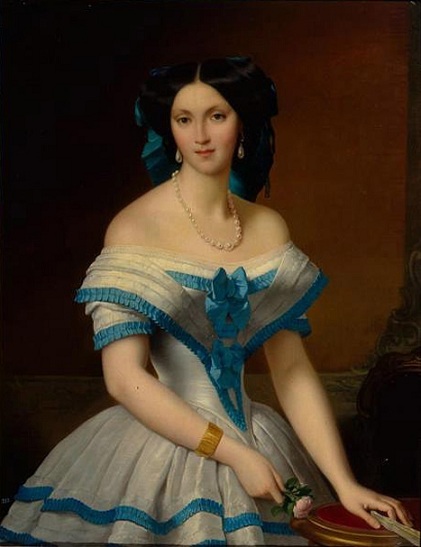
At this point, you have to look at the fact that these women were in corsets or some sort of restrictive garment since they were young teens. I don’t mean girls. Sure, some girls wore corset-type garments. But from a young teen and like 10-, 11-, 12-years old, they’re going to be in a lightly-boned corset.
So by training from that young age, you can alter the waist to a slim figure where it’s naturally going to be smaller because all that torso fat gets pushed to the hips and up to the bust. This creates a smaller waist over time.
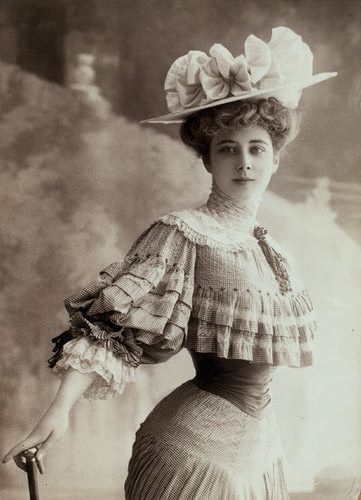
But back to the thought of the teeny, tiny waist thing – you’d think it’s all about “tight-lacing” – NO!
It’s all about the fashionable silhouette. It’s about the appearance. The perception of a small waist.
Women wore a corset to hold things in place. To lift the bust into a fashionable silhouette and support it. Doing so gave her more or less an hourglass shape.
Then what do you do? You add petticoats. You add contraptions like a bustle, a pad, padding to the hips, padding to the bust, petticoats, chemisettes & corset covers that have ruffles on them and dropped shoulder lines. And all this increases the hips and the shoulder appearance. It increases the width. It’s all about illusion.
It’s the impression that the waist is small. They’re not necessarily tight lacing down to 18″. No. Why? Because we have original garments to measure. They don’t measure 18″ in the waist. They measure 22″ to 26″. It’s using trickery to fool the eye into thinking the waist is teeny tiny.
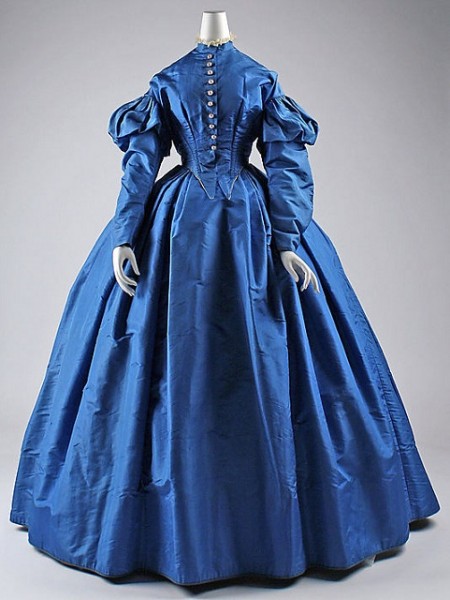
But the thing about corsets is that these women LIVED in them. They took care of kids in them. They went to tea and parties. They got out of bed every morning and put it on just like we get up every morning and put a bra and underwear on. It’s the same thing, it just looks different.
To them, they didn’t know what a bra and panties were. They had been wearing corsets all their lives, same as their mothers and grandmothers, and how many hundreds of years prior to that. Corsets go back quite a long ways.
That’s what they knew. Don’t you think they would have made corsets so that they could actually function yet still be fashionable?
We think of them as if they were fashion plates. Their photographs were of their best dresses. We view them as these stationary people. Not living and breathing, and “Oh, gosh I stubbed my toe on the table! And it hurts and I need to sit down ’cause it’s bleeding now.” “Gosh, I slammed my finger in the door.” Or “Henry’s just asked me out to the ball and I need a new dress.”
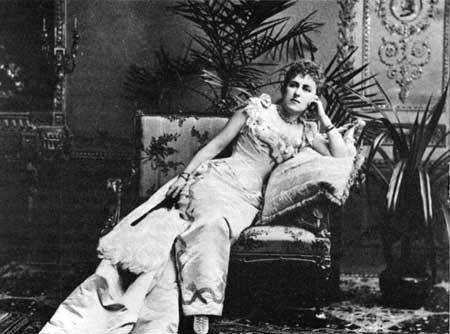
They were still living their lives. Because that’s what they did. We buy weird fashion to dress up and go out to imitate people and to impress other people. But we do it to reflect who we are. And that’s what fashion is. It’s how we connect with society.
They saw celebrities like the Empress Eugenie or Mrs. Vanderbilt with “small” waists. So women tried to imitate their look. Sure, they might have tightened their corsets. But they didn’t go so far as to restrict their movement.
You can’t study 19th C. clothing from a perspective of what would look out of place today. The slender waists we see on these women of the past look so small but that’s only to our 21st C. eyes. Of course they look teeny-tiny compared to our soft, unfitted knit clothing that hides our figures.
I’d bet if you were to put on a well-made, custom-fitted corset, added a strong bustle shape with a dash of proper petticoats – you’d begin to see that slim waistline start to appear. If you did that every day for a month… I’d guarantee you’d discover that itsy-bitsy waist.
Because it’s merely a 21st Century myth that all the waists were 18″.

Like many myths/beliefs about the good old days, please don’t believe that people were “so much shorter” back then because it simply isn’t true. If you look at recruitment records from the Civil War the average height of adult males is only about 1/4 inch less than the 21st century adult male. And those recruits were from all over–recent immigrants, poorly fed farm kids, etc.
A very well-written article — and I buy most of it, I do. I know that by padding hips and pushing up the bust you can make an average size waist look very small. But my family has the dress that my grandmother wore to her high school graduation in 1911. She made it of a fine cotton and embellished it with exquisite drawn-thread decoration. The waistline of that dress measures 17″.
The other thing to remember is that many Victorian photographs were “photoshopped”, where the waist was actually coloured in to appear smaller. Seeing those pictures on Pinterest (without an explanation) helps to keep perpetuating that 21st century misconception.
Dear Jennifer,
I have always wondered if you can achieve the proper silhouette by just putting a corset on without lacing it tight. Would this be true for an s-bend corset too?
All corsets need to be cinched to close. They don’t need to be really tight, only to make a firm foundation for the clothing and support the bust. This would be the same for all 19th C. corsets and Edwardian too.
By the way have you every heard the song “A Corset Can Do a Lot For a Lady?”
I have indeed and most hilarious too.
Richard, speaking as a very plus size woman–no, you can’t achieve the proper silhouette by “just putting it on without lacing it tight.” You don’t have to winch it down to the point where you can’t breathe, and in fact that’s not a good thing to do, but a corset is a garment meant to be worn very snug. Think of a pair of shoes that are too big–your feet slip and slide around in them and you get blisters and sores and rubs and hate them. But if you get a pair of the same style of shoe in a style that is snug to your foot, they’re amazingly the most comfortable shoes you’ve ever worn. The same thing happens with a corset. If it’s not tight enough to stay in place, you get rubs and blisters and pokes. On top of that, a corset provides the foundation to support the bustle and the petticoats and the skirts, and if it’s too loose, the corset slides down and the bustle sags and the petticoats and skirts sag and you look a right mess.
So yeah, you don’t have to tightlace in the sense of making your waist incredibly tiny to look right, but most people in today’s world wear garments much looser than a proper corset should be worn. By modern standards, corsets should be “tight.” Hm. Think…one-piece bathing suit tight, or Spanx tight. It just won’t work otherwise.
Great comparison Varika.
A recent experiment also looked at what actually happens to the body in a corset using MRI and compared to a pregnant woman.
Quite illuminating. The doctor in the program could really only say that maybe there was restrictions in eating. I know I can’t eat a LARGE meal in one go, Small amounts at a time is fine.
And it was interesting how the internal organs go up when a baby is growing inside and thats for 9 months (well really 6 by time they get big enough to start moving things around). At least a corset can be removed each day or during the day or something…baby can’t till its ready to come out so the organs are moved up/around a bit for quite some time.
My former chiropractor was an ardent advocate of the corset, especially the maternity corset. He told me that if we all wore maternity corsets during pregnancy – the right way, not tight laced- the boning would give our backs and hips proper support and we would end up with less back problems during and after the pregnancy.
Height has certainly increased significantly in the 20th century. It is also interesting to note that height decreased in the Europe and America in the 19th century due to industrialisation and increase in poverty. However – and here’s an interesting fact – data from the early parts of 19th century England show great difference in height between the classes – with upper class male youths measuring on averge 22 cm (6.7 inches) taller than their lower class counterparts. It is safe to assume the same would also apply to women at the time, and as we usually only see garments from the upper classes, they might not necessarily reflect the average height of the nation at the time.
Thank you for the article. And to the comments above. We forget that as 21st Century people, we tend to be on the bigger size. My father is 6’7″, his mother (born in 1899) was 6′ even, yet his father was quite average (born in 1876) at 5’7″. I’ve read statistics about many famous figures who are only considered small by modern historians and rarely by their peers. Annie Oakley was 5′; Lily Langtree was around 5’3″; U.S. Grant was 5’8″; W.T. Sherman was considered a lumbering giant at 6′ or 6’1″.
Additionally, when one went to the extreme expense and bother of having a photograph made, they wore their best and perhaps might have snugged it in a bit – for the photo.
Last, I find it fascinating to look at garments from the front and then the side: the Victorian corset changed the “oval” of the waist from side to side to front to back. Many of the garments I see are rather thick through the waist is you look at them side on, but from the front they look entirely teensy. A corset adjusted shape more than pure size.
Another note on the “People were smaller then” subject: Before WWII women usually “passed down” their best dresses to their daughters and/ or nieces. Mom got the new fashion, they re-styled last years’ for the younger relatives. So what you end up with is a dress that’s been cut down to the smallest reasonable size before the style is just inappropriate. So everybody wasn’t necessarily shorter then- the dresses fit on a children’s size 12 mannequin because the dress got sized down to fit a 13 or 14-year-old girl, most probably. Although as always, there are tall and short, large and petite examples of people everywhere in every age.
I read a book that used actresses from the 1940s to model Victorian clothes and they said it also a myth. With the proper corseting and foundations they had no problems using contemporary models with the antique clothes. Most of the ladies had 20-24 inch waists at the time. It all comes down to proportions.
Doris Langley Moore
Quite a good book.
Thanks for the post. I agree with your observations, including your observations about the height of the women — 40″ skirt lengths are common, the skirt length I use and I’m 5″4″. I think it’s also important to remember the dresses that were saved and that we see today are probably the fashionable dresses of young women vs. the more conservative dresses of older women. When I was a teenager and a young woman, my natural waist size was 23″, about the same as the 22″-24″ waist sizes that seem common in extant dresses.
You are right in that it was all about the proportions. After all, someone with a naturally small waist of say 22″, may have a bust and hips of 30-32″ and won’t look that small waisted. Put a corset on someone with a natural 26″ waist and bust and hips of say 36″ and then drop their waist down to 22″ and all of a sudden you have what looks like a teeny tiny waist.
I have a natural hipspring of 12″. I’m 38″, 26″, 38″. If I corset down just 2″, I get a 14″ hipspring. Victorian “ideals” were often for a hipspring in the region of 15 – 20″. That’s WITH all the petticoats and bustles in place. So I would very easily be able to make my waist look minute in Victorian attire. I can however lace down to 20.5″ in a corset I made myself on a course (altered to fit me from a pattern taken from a corset of the 1860s). Which gives a 17.5″ hipspring. Phwoar much? 😉
There are most definitely 18″ corsets in museum collections, but more often than not, they are in impeccable, if not new, condition. Its quite likely that they were wedding corsets which never ended up fitting again. Just think how many woman choose to diet and slim down for their wedding day today. When you look at catalogs for corsets, most only list as small as 18″ and go up to 32″ or 34″. Some have extended size ranges, but those are outside the norm. If you look at the sizes of off the rack corsets today you’ll notice the sizes offered are about the same. We haven’t changed *that* much, we just aren’t used to wearing them!
Another thing to factor in is that yes, woman wanted small waists, or the appearance of such. Often they would order a size smaller than needed and wear it looser (so in effect at the same size) just so that they could say they were wearing a smaller corset. The corsets I wear at 24″ are actually 18″ corsets when fully shut. Bought when my waist was naturally 24″ (intended to give a 6″ reduction when trained down). The smallest I’ve worn them is 22.5″ and then only briefly for a special occasion.
It always was illusion! Retouched photographs, padded busts and hips, even the corset itself creates an illusion. But it was such a lovely lovely illusion!
Thank you for the post, and what a wonderful diversity of comments.
When we look at history we are nearly always presented with problems. Yes, there are not many 18 inch waist dresses in museums, but 19 cent photos do show ladies with both large and really wasp waists. Try http://www.staylace.com – ignore the fetish stuff, but some photos there show un retouched minute waists.
We need to understand that for the teenage girl growing up in the 19 cent a small waist was important. Her mother, aunts etc were all corseted, and her role models had small waists – so she wanted one too. The size of the waist was one of the variables a girl or young woman had over her beauty – make up was considered immoral, dresses were expensive, so one way to be more beautiful was to lace tighter. How many of us here have not suffered in order to appear beautiful? We have not changed.
A tight corset did lots of other things beside waist reduction – posture, deportment, moving, walking – all changed with a corset. Since class distinction was important a restricting corset said ” I come from a class that does not have to work”. Peer pressure etc.
Betty
From an extant clothing standpoint, you are correct. 18″ waists were not the norm. However, it is also important to understand during the 19th century, women were much shorter than today. This is fact. Most costume curators use a child’s standard size 12 dress form to display women’s clothing from this period. They carve down the waist or bust if necessary. So, you are spot on about proportions and illusion when recreating historical attire. We must account for modern height when striving for period silhouettes. -susan
I do agree with you that women were shorter, but I would not say much shorter. In my research I’ve come across dozens of skirt lengths of 40″ or more in the front. I myself am 5’4″ and wear only a 38-39″ length and am only two inches shorter than the current average height. Even allowing for a slightly raised waistline due to petticoats and pads/bustles, that 40″+ still indicates that not all women were under 5 feet tall. And I didn’t know museums used child’s dressforms for women’s garments. I thought they were mostly custom made for the specific silhouettes.
In my studies of tailoring manuals and sets of standard measures from the period, I have found and interesting tidbit. Victorians were shorter, but the height difference is in body length. The skirt lengths are pretty much the same as today, 40″ average. But the body length back then was 7″ from armpit to waist, where today it is 9″ on average. And on stout figures, that length drops to 5-1/2″, with the waistline rising upwards on heavier figures. This also feeds into the illusion of smaller waists, as the angles from waist to bust are more dramatic on a shorter body than a longer one.
Here’s another fascinating example of how our bodies have changed.
I am very small. Small as in just under 4’11”, with a healthy, proportionate figure. I just made some measurements taken from Heather’s post above, and discovered that I do indeed have the 7″ torso, and an even shorter skirt length than the Victorian average. I actually own a custom made 18″ corset, but it’s the one I wear the least. (I’ve put on a bit of weight since it was made, and I do so wish it would go away!) The 18 incher has never been laced tighter than 20″, keeping in mind that 20 yrs and lbs ago, as a teenage ballet student, I had a natural waistline of 19″. (Before you start hating, remember: teenage ballet student = athletically overworked girl with an eating disorder.) These days I wouldn’t even try for less than 22″. But the fit of historical clothes goes WAY beyond just the waistline.
When I see historical clothing in museums, one of the first things I think, apart from utter awe at the beauty of it all, is “Wow! That’s tiny! It’s me-sized! I could wear that!” Then my eyes move from the height and the waist up to the shoulders and sleeves, and I think, “Oh. Never mind then.” The ladies who wore those gowns would not, of course, have had any reason or desire for upper body strength. On the other hand, like so many of us, I work out. I’m proud of my strong shoulders and defined biceps, neither of which would fit into a historical dress that fit the rest of me. I guess I’m trying to illustrate that not only have we changed in height and weight, but we’ve shifted our proportions in many other ways too, ways we wouldn’t often even consider.
Then again, having broader shoulders also can contribute to the teeny-tiny waist illusion! If it works, I’ll take it.
I have tried on many actual Victorian and Edwardian garments because I do historic interpretation from time to time, and prefer originals when I can wear them or at least for study. I live in the Northwest and all I can say is most of those women were much bigger than me – like sturdy Nordic stock or something.
I am 5’6″. My waist is 25″ uncorseted. I have slightly narrow shoulders and slightly wider hips. Most of these dresses are like tents on me, though I have found some my size that require the corset but otherwise fit fine. Not much that is actually smaller than me. Most way taller, way bigger, even with obvious expectation of corsets underneath.
I think all this really depends on WHERE you are, and WHO the majority of the historic people were. English women definitely seemed to be on the tiny side, for example, so when I go to England my experience with antique clothing is very different. I am from a place that definitely was settled by large numbers of Nordic and Dutch people.
My specific problem with wearing antique clothing is, though, as noted above by K. Winter, in the diameter of my arms. I lift weights. I have often put on well preserved dresses that are absolutely my size except for the arms. Sigh.
No one in their right mind would call me ‘slender’ or ‘slim’. I’m ‘ample’ from any point of view. But when I put on my Victorian wear and my wonderful corset suddenly my waist seems to vanish! It’s all in the perception. Viva la illusion!
Fascinating blog and comments! Just wanted to add, since no one has mentioned it, that I’ve seen corsets for pregnancy in some of my Victorian fashion books. While they were lightly boned, they also had elastic insets, to allow for the baby bump! 🙂 So it really was about having the smoothness and support. And girdles were corsets direct descendants!
Another note: while some women in the 1880s adopted “Rational Dress,” based somewhat on ancient Greek and Roman designs, most women did not. And those who did, going with out tight corsets, were referred to as “loose women.” 😀 (Photographs I’ve seen of some of the “fancy women” in the old west showed them wearing loose clothing without corsets, also.) It’s odd that nowadays corsets are thought of as extremely provocative, when they started out just the opposite!
Also taking photos of Mrs Vanderbilt as gospel? Not a good plan. I’ve heard that she made use of “photoshop” and had her negatives ‘touched up’ so that she looked smaller waisted. 😉
Just remember the highly fashionable ALWAYS wore and wear extreme clothing just as they do now. so the goal of a tiny waistline could be the truth for the “Vogue” women of their day. If you didn’t have to work for a living, it allowed you to wear the white dresses and the time consuming frills and fancy trims that take FOREVER to launder and press as well as extreme lacing to produce the tiny waistline.
There is evidence, presented in “The Corset: A Cultural History” (Valerie Steele), that those fashionable flibbertigibbets who corseted that tightly were seen in much the same way as anorexics are by modern society. It’s not that people didn’t do it, but OVERdoing it was considered unhealthy. And immodest; tightlacing was also apparently something of a kink in the Victorian period…
Would someone kindly post a link so I can see paintings that show people sleeping sitting up? This idea is totally new to me and I cannot recall ever seeing one painting or old photo of anyone sitting up to sleep. Thanks in advance.
wow! so much great information…but being a GWTW fan myself I’ll point out that Vivan Leigh had a VERY small waist herself and in the beginning of the film she still managed, while corseted to drop down, reach under a dresser and fetch her parosal while wearing a corset, hoop, petticoat and dress, “Scarlett’s” concern was more about getting through the day without belching.